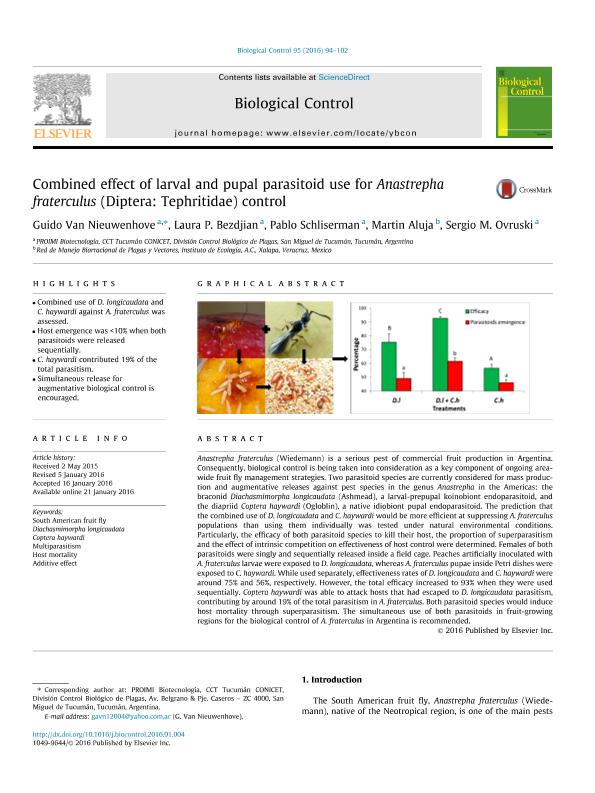Mostrar el registro sencillo del ítem
dc.contributor.author
Van Nieuwenhove, Guido Alejandro

dc.contributor.author
Bezdjian, Laura Patricia

dc.contributor.author
Schliserman, Pablo

dc.contributor.author
Aluja, Martin
dc.contributor.author
Ovruski Alderete, Sergio Marcelo

dc.date.available
2018-02-28T19:28:35Z
dc.date.issued
2016-04
dc.identifier.citation
Van Nieuwenhove, Guido Alejandro; Bezdjian, Laura Patricia; Schliserman, Pablo; Aluja, Martin; Ovruski Alderete, Sergio Marcelo; Combined effect of larval and pupal parasitoid use for Anastrepha fraterculus (Diptera: Tephritidae) control; Academic Press Inc Elsevier Science; Biological Control; 95; 4-2016; 94-102
dc.identifier.issn
1049-9644
dc.identifier.uri
http://hdl.handle.net/11336/37466
dc.description.abstract
Anastrepha fraterculus (Wiedemann) is a serious pest of commercial fruit production in Argentina. Consequently, biological control is being taken into consideration as a key component of ongoing area-wide fruit fly management strategies. Two parasitoid species are currently considered for mass production and augmentative releases against pest species in the genus Anastrepha in the Americas: the braconid Diachasmimorpha longicaudata (Ashmead), a larval-prepupal koinobiont endoparasitoid, and the diapriid Coptera haywardi (Ogloblin), a native idiobiont pupal endoparasitoid. The prediction that the combined use of D. longicaudata and C. haywardi would be more efficient at suppressing A. fraterculus populations than using them individually was tested under natural environmental conditions. Particularly, the efficacy of both parasitoid species to kill their host, the proportion of superparasitism and the effect of intrinsic competition on effectiveness of host control were determined. Females of both parasitoids were singly and sequentially released inside a field cage. Peaches artificially inoculated with A. fraterculus larvae were exposed to D. longicaudata, whereas A. fraterculus pupae inside Petri dishes were exposed to C. haywardi. While used separately, effectiveness rates of D. longicaudata and C. haywardi were around 75% and 56%, respectively. However, the total efficacy increased to 93% when they were used sequentially. Coptera haywardi was able to attack hosts that had escaped to D. longicaudata parasitism, contributing by around 19% of the total parasitism in A. fraterculus. Both parasitoid species would induce host mortality through superparasitism. The simultaneous use of both parasitoids in fruit-growing regions for the biological control of A. fraterculus in Argentina is recommended.
dc.format
application/pdf
dc.language.iso
eng
dc.publisher
Academic Press Inc Elsevier Science

dc.rights
info:eu-repo/semantics/openAccess
dc.rights.uri
https://creativecommons.org/licenses/by-nc-nd/2.5/ar/
dc.subject
Additive Effect
dc.subject
Coptera Haywardi
dc.subject
Diachasmimorpha Longicaudata
dc.subject
Host Mortality
dc.subject
Multiparasitism
dc.subject
South American Fruit Fly
dc.subject.classification
Otras Ciencias Biológicas

dc.subject.classification
Ciencias Biológicas

dc.subject.classification
CIENCIAS NATURALES Y EXACTAS

dc.title
Combined effect of larval and pupal parasitoid use for Anastrepha fraterculus (Diptera: Tephritidae) control
dc.type
info:eu-repo/semantics/article
dc.type
info:ar-repo/semantics/artículo
dc.type
info:eu-repo/semantics/publishedVersion
dc.date.updated
2017-12-04T18:00:37Z
dc.journal.volume
95
dc.journal.pagination
94-102
dc.journal.pais
Estados Unidos

dc.journal.ciudad
Amsterdam
dc.description.fil
Fil: Van Nieuwenhove, Guido Alejandro. Universidad Nacional de Tucumán. Facultad de Ciencias Naturales e Instituto Miguel Lillo; Argentina
dc.description.fil
Fil: Bezdjian, Laura Patricia. Consejo Nacional de Investigaciones Científicas y Técnicas. Centro Científico Tecnológico Conicet - Tucuman. Planta Piloto de Procesos Industriales Microbiologicos; Argentina
dc.description.fil
Fil: Schliserman, Pablo. Consejo Nacional de Investigaciones Científicas y Técnicas. Centro Científico Tecnológico Conicet - Tucuman. Planta Piloto de Procesos Industriales Microbiologicos; Argentina
dc.description.fil
Fil: Aluja, Martin. Consejo Nacional de Ciencia y Tecnología. Instituto de Ecología; México
dc.description.fil
Fil: Ovruski Alderete, Sergio Marcelo. Consejo Nacional de Investigaciones Científicas y Técnicas. Centro Científico Tecnológico Conicet - Tucuman. Planta Piloto de Procesos Industriales Microbiologicos; Argentina
dc.journal.title
Biological Control

dc.relation.alternativeid
info:eu-repo/semantics/altIdentifier/url/http://www.sciencedirect.com/science/article/pii/S1049964416300044
dc.relation.alternativeid
info:eu-repo/semantics/altIdentifier/doi/http://dx.doi.org/10.1016/j.biocontrol.2016.01.004
Archivos asociados
